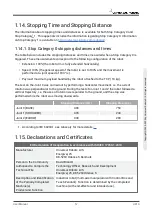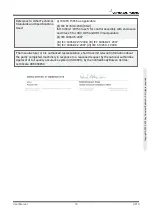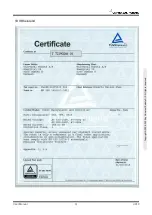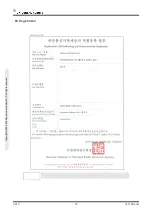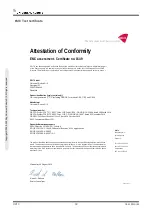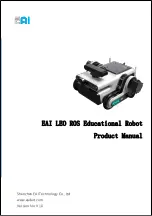
ISO 12100:2010
EN ISO 12100:2010 (E) [2006/42/EC]
Safety of machinery – General principles for design – Risk assessment and risk reduction
UR robots are evaluated according to the principles of this standard.
ISO 10218-1:2011
EN ISO 10218-1:2011(E) [2006/42/EC]
Robots and robotic devices – Safety requirements for industrial robots
Part 1: Robots
This standard is intended for the robot manufacturer, not the integrator. The second part
(ISO 10218-2) is intended for the robot integrator, as it deals with the installation and design of
the robot application.
The writers of the standard implicitly envisioned traditional industrial robots, which are
traditionally safeguarded by fences and light curtains. UR robots are designed with force and
power limiting enabled at all times. Therefore, some concepts are clarified and explained below.
If a UR robot is used in a hazardous application, additional safety measures might be required,
see
of this manual.
Clarification:
• "3.24.3 Safeguarded space" is defined by the perimeter safeguarding. Typically, the
safeguarded space is a space behind a fence, which protects people from the hazardous
traditional robots. UR robots are designed to work without a fence using built-in power and
force limiting collaborative safety functions, and therefore without a hazardous
safeguarded space defined by the perimeter of a fence.
• "5.4.2 Performance requirement". All safety functions are constructed as PLd according to
ISO 13849-1:2006. The robot is constructed with redundant encoder systems in each joint,
and the safety-rated I/Os are constructed with a Category 3
1
structure. The safety-rated
I/Os must be connected according to this manual to Category 3 safety-rated equipment to
form a PLd structure of the complete safety function.
• "5.7 Operating modes". UR robots do not have different operating modes and therefore they
do not have a mode selector.
• "5.8 Pendant controls". This section defines protective features for the teach pendant,
when it is to be used within a hazardous safeguarded space. Since UR robots are designed
for collaborative operation, there is no hazardous safeguarded space like with traditional
robots. UR robots are safer to teach than traditional robots. Instead of having to release a
three-positioning enabling device, the operator can simply stop the robot with his hand. If a
1
According to ISO 13849-1, see Glossary for more details.
UR10
70
User Manual
C
o
p
yr
ig
h
t
©
2
0
0
9
–
2
0
2
0
b
y
U
n
iv
e
rs
a
l
R
o
b
o
ts
A
/S
.
A
ll
ri
g
h
ts
re
s
e
rv
e
d
.
Summary of Contents for UR10/CB3
Page 1: ...Universal Robots User Manual UR10 CB3 Original instructions en...
Page 28: ...UR10 20 User Manual Copyright 2009 2020 by Universal Robots A S All rights reserved...
Page 30: ...UR10 22 User Manual Copyright 2009 2020 by Universal Robots A S All rights reserved...
Page 36: ...UR10 28 User Manual Copyright 2009 2020 by Universal Robots A S All rights reserved...
Page 56: ...UR10 48 User Manual Copyright 2009 2020 by Universal Robots A S All rights reserved...
Page 62: ...UR10 54 User Manual Copyright 2009 2020 by Universal Robots A S All rights reserved...
Page 64: ...UR10 56 User Manual Copyright 2009 2020 by Universal Robots A S All rights reserved...
Page 72: ...China RoHS UR10 64 User Manual Copyright 2009 2020 by Universal Robots A S All rights reserved...
Page 73: ...KCC Safety User Manual 65 UR10 Copyright 2009 2020 by Universal Robots A S All rights reserved...
Page 92: ...UR10 84 User Manual Copyright 2009 2020 by Universal Robots A S All rights reserved...
Page 116: ...UR10 108 User Manual Copyright 2009 2020 by Universal Robots A S All rights reserved...
Page 124: ...UR10 116 User Manual Copyright 2009 2020 by Universal Robots A S All rights reserved...
Page 164: ...UR10 156 User Manual Copyright 2009 2020 by Universal Robots A S All rights reserved...
Page 214: ...UR10 206 User Manual Copyright 2009 2020 by Universal Robots A S All rights reserved...


